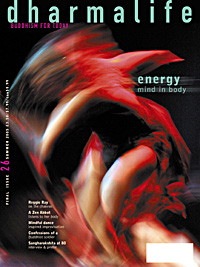Being a Buddhist Nun
The Struggle for Enlightenment in the Himalayas
Author: Kim Gutschow
Harvard University Press 2004, $29.95/£19.95p/b, 334pp
If the cover photograph with its Himalayan peaks reaching into an infinite blue sky or the sub-title lead you to expect an inspiring encounter with practitioners of the Buddha's way struggling to develop those same virtues of wisdom and compassion that may be your goals, you will be disappointed. Nevertheless, Kim Gutschow's book has its own interest and appeal. It raises pertinent questions for contemporary Buddhists: the impact of economic and 'religious' values on the actual practice of Dharma-farers; the differences between men and women and the relations between them; and how best to create a bridge between traditional cultural norms, which have shaped centuries of Dharma practice, and a life that marries commitment with a capacity to live in the modern or modernising world.
Over a period of 14 years, Gutschow made annual visits to a remote area of Kashmir known as Zanskar. Her mission was to discover how Buddhist nuns of the Himalayan region actually live. The author spent time in all the nine Zanskari nunneries, fostering relations with the nuns and becoming acquainted with their lives in intimate detail - their daily routines, their rituals, their backgrounds.
The author's research leaves her with some pressing points to make. Having sketched the geographical, political, religious and economic context of the lives of the Zanskari peoples from which her nuns emerge, she focuses on the key issue of her book: the inequality between monks and nuns, economic inequality in particular, as well as the related inequality of status and opportunity.
'Why did it take the nuns almost half a century to accomplish a feat [erecting a small building] that monks might complete within a single year?', she asks. The reason is that monks traditionally perform the rituals that draw the support of lay people, while nuns perform more menial tasks, including many for the monks, and they continue to work the fields for their families. Nuns are trapped in a cycle of poverty, lack of education and learning, while monks enjoy wealth and prestige in the local community.
In a fascinating analysis of merit-making, which she calls 'the Buddhist Economy', Gutschow argues that there is a discrepancy between such Buddhist doctrines as the teaching of renunciation leading to the experience of non-duality, and practices motivated by the economy of merit-making, which are rooted in quite different attitudes and beliefs.
In her exploration of the effect of gender on Zanskari monastic life, she does not hold back in uncovering apparent inconsistencies or even abject prejudices. 'In Zanskar Buddhist culture, women are dangerous because of their impurity as well as their sexuality, while they are also in danger because their purity can be defiled. Monks rectify the danger of female impurity by ritual cleansing.' Gutschow points out that according to the Dhammapada one person can neither defile nor purify another. Furthermore, it is by one's actions that one is defiled or purified, not by the natural processes of menstruation, child-birth, or simply having a female form.
One can feel on occasion that the author goes too far in trying to expose the oppressions of the nuns - that there may be another side to the story if one were to look from inside the monastery across to the nunnery. And yet her anecdotes and analyses are sobering.
Kalyanaprabha was the editor of Lotus Realm magazine for Buddhist women



